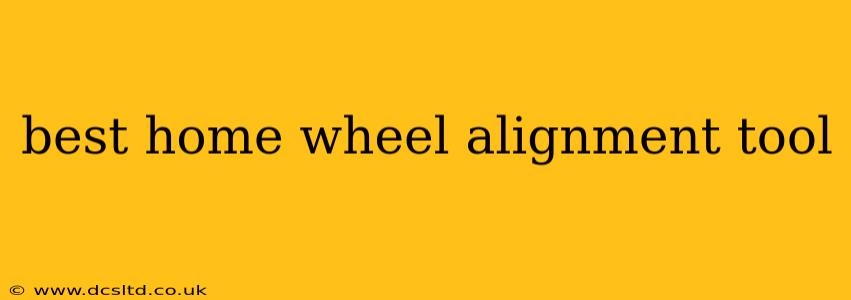Achieving perfect wheel alignment is crucial for optimal vehicle handling, fuel efficiency, and tire longevity. While professional shops offer precise alignment services, many car enthusiasts and budget-conscious individuals seek affordable and convenient at-home solutions. This guide explores the best home wheel alignment tools available, helping you choose the right one for your needs and skill level. We’ll also delve into the nuances of DIY alignment, addressing common questions and concerns.
What is Wheel Alignment, and Why is it Important?
Wheel alignment refers to the precise positioning of your wheels relative to each other and the vehicle's frame. Three key angles determine your alignment:
- Camber: The angle of the wheels when viewed from the front, tilting inward (negative camber) or outward (positive camber).
- Caster: The angle of the steering axis viewed from the side, influencing steering stability and return.
- Toe: The inward (toe-in) or outward (toe-out) angle of the wheels as seen from above.
Improper alignment leads to uneven tire wear, poor handling, reduced fuel economy, and potentially unsafe driving conditions.
What are the Best Home Wheel Alignment Tools?
The best home wheel alignment tool depends on your budget and technical expertise. Options range from simple measuring tools to more sophisticated laser-based systems.
1. String Alignment Method: This is the most basic and affordable method. It involves using strings and measuring tapes to determine toe angle. While simple, it's less accurate than other methods and primarily suitable for rough adjustments.
2. Digital Angle Finder: These tools provide a more precise measurement of camber and caster angles than the string method. They usually involve attaching a sensor to the wheel and using a display to read the angles. These offer better accuracy than string methods but still lack the precision of professional equipment.
3. Laser Alignment Tools: These are the most advanced home alignment tools available, offering comparable accuracy to professional shop equipment. Laser alignment systems project laser beams to precisely measure toe, camber, and caster angles. They are more expensive but provide the best results for a DIY approach.
4. Wheel Alignment Gauge Sets: These kits typically include a combination of tools, like measuring tapes, gauges and sometimes angle finders, offering a more comprehensive approach than relying on single tools. The accuracy varies depending on the kit's components.
Choosing the Right Tool for Your Needs
Consider the following factors when selecting a home wheel alignment tool:
- Accuracy: Laser alignment systems offer the highest accuracy, followed by digital angle finders and string methods.
- Ease of Use: String methods are the simplest, while laser systems can be more complex to set up and operate.
- Cost: String methods are the cheapest, with laser systems being significantly more expensive.
- Your Mechanical Skills: While all methods can be done by a DIYer, more advanced tools demand a better understanding of vehicle mechanics and alignment principles.
How Accurate Are Home Alignment Tools Compared to Professional Shops?
Home alignment tools, particularly laser systems, can achieve a reasonable level of accuracy. However, professional shops utilize advanced equipment and calibrated settings ensuring higher precision and consistency. For critical adjustments or if you lack experience, a professional alignment is always recommended.
Can I Do a Wheel Alignment Myself at Home?
Yes, you can perform a basic wheel alignment at home, especially toe adjustments, using relatively simple tools. However, complex adjustments to camber and caster angles might require specialized equipment and expertise. Always consult your vehicle's owner's manual for specific recommendations and torque specifications.
What Tools Do I Need for a Basic Wheel Alignment at Home?
A basic at-home alignment might require a measuring tape, strings, and possibly a level for a rudimentary toe adjustment. More advanced methods necessitate digital angle finders or laser alignment systems.
What are the Risks of Doing Wheel Alignment Myself?
Incorrect alignment can lead to unsafe driving conditions, rapid tire wear, and damage to your vehicle's suspension components. If you are not confident in your mechanical abilities, it's best to seek professional assistance.
This comprehensive guide provides a detailed overview of home wheel alignment tools, enabling you to make an informed decision based on your specific needs and mechanical expertise. Remember, safety should always be your top priority, and consulting a professional is always an option if you have any doubts.
